Many people ask about exercising after getting Botox or dermal fillers. These popular cosmetic treatments take less than an hour and need minimal recovery time, but your aftercare routine plays a substantial role in getting the best results. This piece explains when it’s okay to exercise after Botox or dermal filler treatments, and you’ll learn which activities are safe and what precautions protect your investment.
Why Exercise Is Restricted After Botox and Fillers
Your Botox or dermal filler treatment needs proper aftercare to work best. Medical experts suggest limiting physical activity to protect your results, and they have good reasons to do so.
Increased Blood Flow and Botox or Filler Migration Risk
Exercise can change how Botox and dermal fillers settle in your facial muscles. Your heart rate goes up during a workout, which sends more blood flowing through your body and face. This extra blood flow might make the filler material or botulinum toxin move away from where it should stay.
Studies show that botulinum toxin shots actually increase blood flow in human skin and raise its temperature. This natural boost in blood flow, combined with exercise-induced circulation, creates perfect conditions that let the toxin move around.
More specifically, these are the physical changes you may experience if you work out too soon after treatment:
- Your heart rate and blood pressure push the product beyond the target muscles.
- More blood flow dilutes the concentration at injection spots.
- Extra circulation makes bruising and swelling more likely.
- Temporary drooping eyelids (ptosis).
- Uneven eyebrows or asymmetrical facial expressions.
- Difficulty with normal facial movements.
- In rare cases, issues with speaking or swallowing.
Hard workouts might also let Botox spread through blood vessels (hematogenously), which could affect muscles that weren’t part of your treatment plan.
Increased Bruising and Swelling
Exercise changes how your body heals after cosmetic injections. Blood flows more to treated areas during intense workouts, which can slow your recovery. Heart rate spikes make bruising more likely around injection sites.
On top of that, workout sweat can irritate fresh treatment areas. Wiping sweat from your face adds pressure and bacteria to injection sites—both can slow down healing.
Facial Pressure from Gear or Wiping Sweat
Speaking of which, pressure on treated areas needs careful attention. You might touch your face or wipe sweat without thinking during exercise. Clinical guidelines say you should keep hands off your face for at least four hours after treatment.
Some workout gear can squeeze injection sites, too. Swimming caps, goggles, bike helmets, or tight headbands might press down and move the neurotoxin around. This pressure could push the product away from its target spot, which hurts both how it looks and how long it lasts.
Muscle Movement and Toxin Diffusion
Botox works by stopping acetylcholine release, which blocks neurotransmitter responses and reduces muscle tone. The toxin needs time to bind properly with nerve endings in the target area. Too much facial movement during this vital period can mess up this process by breaking down the product before it settles into your muscles.
Worst case scenarios might let botulinum toxin leak into your bloodstream and cause side effects. This rarely happens with cosmetic treatments, but it shows why following aftercare rules matters so much.
Reduced Effectiveness of Treatment
Perhaps the biggest problem is that early exercise might hurt your results. Active movements can break down Botox or dermal filler before it blends with your muscles. Studies show increased blood flow might dilute the treatment at injection sites, and this is a big deal as it means that your results won’t last as long.
Research also suggests that high-intensity workouts might shorten how long Botox lasts. Exercise boosts insulin-like growth factor levels, which could speed up nerve regrowth in muscle tissue. This works against Botox’s nerve-blocking effects.
A short 24- to 48-hour break from workouts can improve your chances of getting the best, longest-lasting results. Your patience during this time helps the treatment work exactly as intended.
How Long After Botox or Dermal Filler Treatments Can You Work Out?
The right timing makes all the difference when you start physical activities after Botox injections. Your Beauty Vault provider gives you specific post-treatment instructions to help you get the best results and avoid complications.
Four-Hour Minimum for Light Activity
The neurotoxin needs proper settling time right after your Botox or dermal filler treatment. Medical professionals ask patients to avoid any physical activity for at least four hours after the injection. This time allows dermal fillers to settle or Botox to bind correctly to the neuromuscular junction without any disruption.
After this four-hour window, you can start doing light activities that won’t raise your heart rate or blood pressure much. Just remember to stay upright and avoid lying down or bending over during these gentle activities, as this could affect how the Botox settles.
24-hour Wait for Moderate to Intense Workouts
Your regular exercise routine might be calling, but doctors strongly suggest waiting 24 hours before any strenuous physical activity. This waiting period lets the Botox or dermal fillers settle properly into the targeted tissues without moving to other areas.
Stay away from these moderate to intense activities during the first 24 hours post-treatment:
- Running, jogging, or high-intensity cardio
- Weight training or strenuous strength exercises
- Cycling, rowing, or aerobics
- Swimming (especially with goggles)
- Contact sports or activities with risk of facial impact
- Floor-based exercises, including traditional yoga and Pilates
Why Some Providers Recommend Waiting One Week
A 24-hour wait works for most patients, but your Beauty Vault provider may suggest putting off intense exercise for a full week. This is especially true for Botox, which faces the highest risk of displacement in the first 24 to 48 hours after treatment. The settling process continues even after this time. A longer waiting period could be beneficial for patients who:
- Got treatment in sensitive or critical areas.
- Had migration issues with past treatments.
- Do very intense exercise routines.
- Have sensitive skin.
Safe Activities to Do After Botox and Fillers
You don’t need to stay completely inactive after your Botox or filler treatment. Many activities are safe and might even help your results. Knowing which exercises work best will help you maintain your fitness routine without affecting your esthetic outcomes.
Facial Exercises Like Smiling and Frowning
In stark comparison to this idea of avoiding all movement, doctors often recommend facial exercises after Botox injections. Patients who do facial exercises might see results in two to three days, while those who don’t may have to wait three to four days.
To get the best results, try these simple facial movements about four hours after your treatment:
- Raise and lower your eyebrows (as if surprised)
- Press your eyebrows together (like squinting)
- Smile widely and then relax
- Frown and then relax
Medical experts suggest doing three sets of 40 repetitions with 10-minute breaks between sets. These movements help spread the Botox through the targeted muscles and might speed up your results.
Gentle Walking and Light Housework
Light physical activity works well shortly after your Botox treatment. Again, many clinics allow gentle exercise after the first four-hour waiting period. Safe activities include:
- Easy walking at a relaxed pace
- Light housework or gardening
- Gentle stretching while standing
- Meditation and breathing exercises
- Light jogging, but only if your provider says it’s okay
These low-intensity movements keep you active without increasing blood flow to your face too much. Some movement benefits your overall circulation with no adverse effects your Botox results.
Talk with the Beauty Vault About Prioritizing Recovery for Optimal Results
Your post-treatment choices will substantially affect your overall health and the results of your Botox or dermal fillers. Having an aftercare plan for exercise is crucial to enjoying a successful procedure. The Beauty Vault team in West Hollywood is prepared to help you create the perfect plan for your needs and lifestyle. Schedule a consultation today by calling them at (323) 800-6770 or filling out a contact form.
FAQs
Q1. How soon can I resume exercising after Botox or filler treatments? It’s generally recommended to wait at least 24 hours before engaging in any strenuous exercise after receiving Botox or filler injections. This waiting period allows the treatment to settle properly without the risk of migration.
Q2. Are there any safe activities I can do immediately after Botox? Light activities such as gentle walking, easy stretching while standing, and facial exercises (like smiling and frowning) are usually safe to perform after the initial four-hour waiting period. However, always follow your specific provider’s instructions.
Q3. Can exercise negatively impact my Botox results? Yes, exercising too soon after Botox can potentially affect your results. Increased blood flow from physical activity may cause the Botox to migrate from the targeted areas, potentially leading to facial asymmetry or reduced effectiveness of the treatment.
Q5. Why do some providers recommend waiting a week before exercising? Some providers may suggest waiting up to a week before resuming high-impact or strenuous exercise, especially for patients who received treatment in sensitive areas, have experienced migration issues before, or participate in particularly vigorous exercise routines. This extended timeframe allows for complete settling of the treatment.








